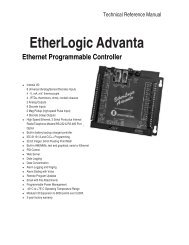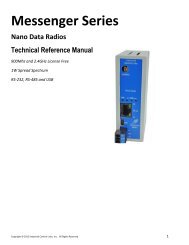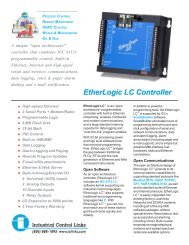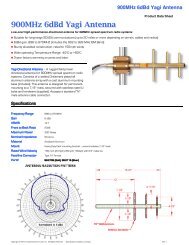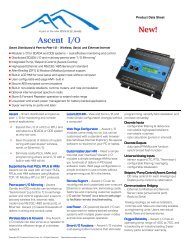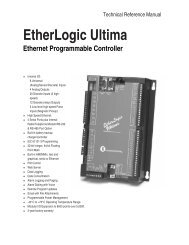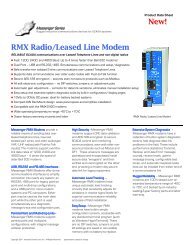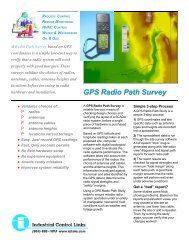9XTend-PKG-R™ RS-232/485 RF Modem
9XTend-PKG-R™ RS-232/485 RF Modem
9XTend-PKG-R™ RS-232/485 RF Modem
- No tags were found...
Create successful ePaper yourself
Turn your PDF publications into a flip-book with our unique Google optimized e-Paper software.
<strong>9XTend</strong>‐<strong>PKG</strong>‐R <strong>RS</strong>‐<strong>232</strong>/<strong>485</strong> <strong>RF</strong> <strong>Modem</strong> – Product Manual v1.2.45.4. Multi-Transmit ModeAttributes:Reliable Delivery through forced transmission of every <strong>RF</strong> packetEvery <strong>RF</strong> packet is sent exactly (MT + 1) times with no delays between packetsDiminished throughput and increased latencyRequired Parameter Values (TX <strong>Modem</strong>): MT (Multi-Transmit) >= 1Other Related Commands: Networking (DT, MK, MY, RN, TT), Serial Interfacing (BR, PK, RB,RO), <strong>RF</strong> Interfacing (FS)Recommended Use: Use for applications that require Reliable Delivery without using retries andacknowledgements.5.4.1. Connection SequenceEvents up through the ‘Transmit Packet’process are common to all three <strong>RF</strong>Communication Options. Refer to the TransmitMode section [p14] for more information.Figure 5‐05. Multi‐Transmit Mode State DiagramIn Multi-Transmit mode, each packet is retransmitted MTtimes, for a total of (MT+1) transmissions. There is nodelay between retransmissions, and the transmittingmodem will never receive <strong>RF</strong> data between retransmissions.Each retransmission includes an <strong>RF</strong> initializer. Atransmission event may include follow-on packets, each ofwhich will be retransmitted MT times. The Forced Sync (FS)parameter is ignored in multiple-transmission mode.The RB and RO parameters are not applied to follow-onpackets, meaning that once transmission has begun, it willcontinue uninterrupted until the DI buffer is empty or thestreaming limit (TT) has been reached. As with the firstpacket, the payload of each follow-on packet includes up tothe maximum packet size (PK) bytes, and the transmittingmodem checks for more pending data near the end of eachpacket. Follow-on packets are not sent until allretransmissions of the previous packet are finished.The streaming limit (TT) is specified at the transmittingmodem as the maximum number of bytes that thetransmitting modem can send in one transmission event,which may consist of many packets. If the TT parameter isreached, the transmitting modem will force a random delayof 1 to RN delay slots (exactly 1 delay slot if RN is zero). InMulti-Transmit mode, each packet is counted only oncewhen tracking the streaming limit (TT), no matter howmany times it is retransmitted.When a receiving modem receives a Multi-Transmit packet,it calculates the amount of time remaining in the Multi-Transmit event, and inhibits its own transmissions for theduration of the Multi-Transmit event, plus a randomnumber of delay slots between 0 and (RN-1). If the local RNparameter is zero, the delay is only for the calculated duration of the Multi-Transmit event. Thus,a receiving modem need only receive one of the transmissions, and it will keep off the channeluntil the transmitting modem is done. If follow-on packets are coming, the receiving modems willmove to the new frequency and listen for the follow-on packet for a specific period of time.© 2005 MaxStream, Inc. Confidential and Proprietary 45



